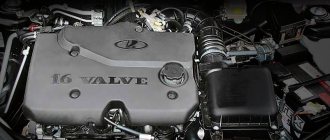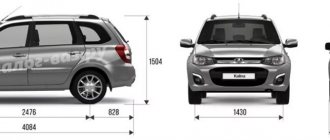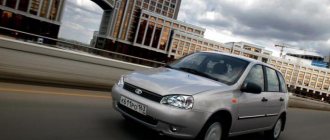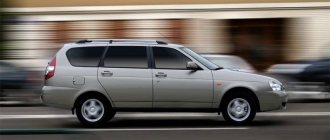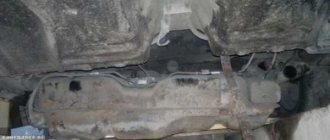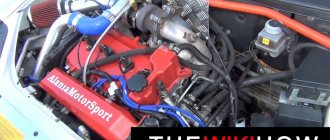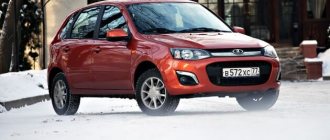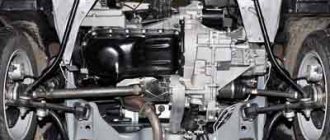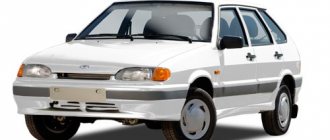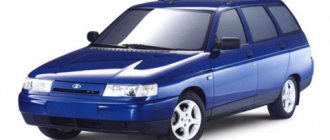Model 2111 (Lada 111) produced by AvtoVAZ is a logical continuation of the 2110 sedan. This is a five-seat front-wheel drive station wagon, created primarily for family use and transportation of small loads. Let's look at the technical characteristics of the VAZ 2111, overall dimensions, design and safety level, as well as the pros and cons of the 11th model.
Although the station wagon is no longer produced, there are still many of these cars on the used car market. Therefore, the description of the characteristics of the eleventh Lada is still relevant. The modification and characteristics of the car also depend on the year of manufacture of the Lada.
List of modifications of Lada 2111
This model was produced from 1998 to 2014. During this time, the following modifications of the VAZ 2111 came off the assembly line.
| Modifications | Characteristics | Years of manufacture |
| 21111 | With a 71-horsepower 8-valve 1.5-liter engine. | Produced from 1998 to 2004. |
| VAZ 21110 | More powerful engine with 77 hp. With. and a volume of 1.5 liters has 8 valves. | Produced from 2000 to 2009. |
| 21112 | A 1.6-liter power unit with even more power - 82 hp. With. and 8 valves. | 2004–2009. |
| 21113 | The number of valves has been increased to 16, volume 1.5 l, power 93 l. With. | Released in 2002. |
| 21114 | 16-valve 89-horsepower 1.6-liter engine. | 2004–2009. |
From 1999 to 2009, AvtoVAZ produced an alternative all-wheel drive version 2111-90, also known as Tarzan 2. A trial model Lada 21116 was also produced, equipped with a 2-liter Opel C20XE engine with a power of 150 horsepower. In 2009, AvtoVAZ stopped producing the Lada 2111, then from 2009 to 2014 the car was produced by Ukrainian forces. The name was also changed - Bogdan-2111.
The very first version of the car was equipped with a carburetor engine.
From the history
(export name Lada 111
) - the first front-wheel drive VAZ station wagon, mass-produced since the end of 1998.
The development of the VAZ-2111 model was carried out in parallel with the base VAZ-2110.
It all started in 1985 with the search for the shape of the rear.
Layout of the 100 series in two versions. The left half was made by A. Ruzanov, the right half by S. Zaitsev (1986).
During testing, the
station wagon
had a hard time on the cobblestones - 500 kg of load is no joke.
There were problems with the spars. There were a lot of problems with the trunk shelf. From the very beginning, the shelf rose when the back door was opened. There was a problem on the station wagon
with the rear seat mount.
Full-scale plasticine model of a station wagon based on the 100a series. 1987
Noteworthy are the original door handles built into the glass next to the stacked windows. Didn't pass - difficult to manufacture.
Regarding the “hundred-gram windows,” experts from Belgium said that a sunroof would definitely be needed, or better yet, an air conditioner so that people would not feel discomfort.
On the 200 series a sunroof appeared. Although it was welcomed, and there was a trend and fashion in those years, the plant did not yet have experience with it, the technology had not been developed, so the hatch had to be abandoned.
We tried something else - a fixed front window (and, in fact, this can no longer be called a window, since it did not open), and behind it - an ordinary sliding glass. This pseudo-window had a spherical shape so that the difference between the surface and the glass was minimal. All this is for better aerodynamics.
Later, the original hundred-gram windows were removed. To begin with, the front door glass was divided into two halves. The front part, made of spherical glass, was rigidly fixed (for better aerodynamics), and the rear part was lowering. All the glass at the rear side door rolled down.
In 1997, a pilot production batch of VAZ-2111 was produced. The body was made at SKP, the car was driven along the conveyor belt, and the entire rear part was assembled at the OPP. It was like this for about a year. Since 1998, the station wagon has been completely assembled.
Chronology
- appeared already at the beginning of 1989. 11 VAZ-2111 units were produced. All tests required by technical specifications and regulatory documents were carried out.
— manufactured in 1993–94. 16 VAZ-2111 units were produced.
- manufactured in 1994 - 95. 2 VAZ-2111 units were produced.
— was produced in 1995. Mass experimental-industrial batch. 2 VAZ-2111 units were produced.
Description
The engine on this car can be used in one of two options: with electronically controlled multipoint injection (each cylinder has its own injector) and an electronic ignition system. The 1.5-liter engine with 8 valves provides sufficient power (56 kW) and torque (118 Nm) with moderate fuel consumption. The engine has a displacement of 1.5 liters, with 16 valves, a twin-shaft cylinder head, providing increased power (69 kW) and torque (130 Nm), allowing the car to have improved dynamic qualities. All station wagons are equipped with a “short” main gear (3.9 instead of 3.7 in the VAZ-2110). With a total weight increased by 20 kg, the smoothness of the ride has even increased compared to the sedan.
The VAZ-2111 is available in three modifications - the basic 2111 with an injection engine, 21111 with a carburetor engine, and 21113 with a sixteen-valve engine and 14-inch wheels. Basic VAZ-2111 (VAZ-21102 sedan) with a 1.5-liter VAZ-2111 engine; VAZ-21111 with a conventional 1.5-liter VAZ-21083 engine; VAZ-21113 with a 16-valve VAZ-2112 power unit and improved brakes (analogous to the VAZ-21103 sedan).
The VAZ-2111-90 “Tarzan 2” is an all-wheel drive vehicle with a 4x4 wheel arrangement. The power unit, transmission and chassis are used from the VAZ-21213. “Tarzan 2” combines the comfort and convenience of the VAZ-2111 and the cross-country ability of Niva vehicles.
The following versions are available - “standard” (VAZ-21110-00 and VAZ-21113-00), “norm” (VAZ-21110-01 and VAZ-21113-01) and “luxury” (VAZ-21110-02 and VAZ -21113-02).
No frills
The Russian station wagon looks quite attractive from some angles, especially its front part - with nice headlights and a laconic radiator grille.
However, the heavy rear introduces serious disharmony into the appearance of the car - it “squats” to the ground even when the interior is unloaded, and when fully loaded it completely outweighs the front end.
Despite the acceptable ground clearance of 175 millimeters, you should be careful when driving on bumpy terrain. The reason lies, again, in the low overhang of the stern.
Familiar motives
The architecture of the front panel is completely identical to that of the VAZ 2110. The instrument panel looks simple, but is perfectly readable due to the large digitization and green backlight.
The trip computer, which is located on the center console, provides an indication of unlocked doors and warning lamps, and a clock is installed to the right of it. The air conditioning system has intuitive and clear controls, but the sound of its fan is very intrusive.
The driver's seat with a flat profile and weak lateral support distributes body weight unevenly, which is why the limbs may become numb and discomfort may appear in the back on a long journey.
Moreover, the range of seat adjustment in the longitudinal direction will seem insignificant for a tall driver. It’s also a bit cramped on the back sofa - if you’re 180 centimeters tall, you’ll have to accept the fact that your knees will have to be spread apart so as not to rest against the backs of the front seats.
The luggage compartment volume is 423 liters - not the most outstanding figure. However, when folding the second row seats, you can achieve a quite acceptable 1420 liters.
Linear dimensions of the VAZ and exterior
The dimensions of all VAZ cars of this model are almost the same:
- length - 4.285 m;
- width - 1.68 m;
- height - 1.48 m;
- rear track - 1.37 m;
- front track - 1.4 m;
- wheelbase - 2.492 m;
- weight - 1050 kg;
- driving pair of wheels - front;
- number of doors - 4;
- seats - 5;
- body type - station wagon.
Newer modifications 21112, 21113, 21114 have ground clearance of 165 mm, while the first versions of the station wagon have ground clearance of 160 mm. There are three types of tires: 175/70R13, 175/65R14 and 185/60R14. The tire size is affected by the configuration. The first number indicates the width of the tire, the second is the percentage of the tire profile to the width. The designation R indicates that the tire type is radial. The last number is equal to the mounting diameter of the disk in inches.
The appearance of the 111th Lada is nice. The body is created on the platform of the 2110 sedan, the appearance of which was the result of a complete restyling of models of previous years. The line of cars 2110, 2111 can be safely called the first modern cars made by AvtoVAZ.
Streamlining has been improved, new narrow headlights have been introduced. The car has a “lanky” shape in profile. The radiator grille and air intake are separated by a license plate; there are no bulges along the entire perimeter of the body. The side “skirts” are trimmed with black plastic, and in some modifications the bumpers are also trimmed.
The design of this model is classic, and when painted in any color, the VAZ looks solid.
Length
The geometry of the VAZ 2110 body is described in the operating instructions. The main parameters for checking body geometry are as follows:
- There should be 4.265 meters between the extreme points of the front bumper and the rear bumper.
- The distance between the center of the front wheel and the center of the corresponding rear wheel is 2.492 meters.
- The distance from the center of the front wheel to the end point of the front bumper is 0.829 meters.
- The distance from the center of the rear wheel to the end point of the rear bumper should be 0.944 meters.
Characteristics of Lada 111 engines
All engines of the Lada 2111 are located transversely. Each engine is equipped with 4 cylinders lined up in a row. The very first 71-horsepower engine has 8 valves. The main feature of the first modification is the presence of a carburetor. In all subsequent versions of the station wagon, gasoline is pumped into the engine by an injector. The maximum torque of the first VAZ 111 engine is 104 Nm. With such an engine, the car accelerates to hundreds in 14 seconds, and the top speed is 160 km/h. Gasoline consumption is: 9.1 liters per 100 km in the city, 5.6 liters on the highway, 7.7 liters in the combined cycle.
The 77-horsepower engine can develop a torque of 110 Nm. The car spends 15 seconds to “exchange” hundreds and can reach a speed of 160 km/h. With this unit, the VAZ 2111 fuel consumption is 10/5.7/7.3 liters.
The next VAZ engine - the last of the 8-valve ones - has a power of 82 horsepower. It is capable of developing a torque of 120 Nm. The maximum speedometer scale is 165 km/h, and the 100 km/h mark is overcome in 14 seconds. Fuel consumption: 8.5/5.5/7.2 l.
This completes the line of 8V engines. The remaining two engines each have 16 valves under the hood. The first of these, the most powerful, 93-horsepower engine, can achieve a torque of as much as 131 Nm. At the same time, less is spent on typing hundreds - 13 seconds. The maximum speed has also increased - 175 km/h. Relatively little fuel is consumed: 8.7/5.5/7.5 liters per 100 km.
And the latest 2111 engine also has 16 valves in its arsenal. The maximum torque is 128 Nm, with which the Lada accelerates to 100 km/h in just 12.5 s. This is a record among all modifications. The speedometer needle peaks at 175 km/h. The consumption of this dynamic unit is: 8.8/5.5/7.5 liters.
The low weight allows the VAZ 2111 to demonstrate good dynamic characteristics. All units are recommended to be fueled with AI-92 fuel.
Interior
The “inner world” of the Lada 2111 is rather meager by modern standards. But for a car whose design was developed in the 90s, the interior is decent. The general appearance of the dashboard and instrument console looks original. Before the release of 2110 and 2111, VAZ did not implement anything like this. Stepwise transitions of lines are observed. Finishing plastic has a rough structure. This adds reliability both visually and in feel.
The interior design, as well as the exterior, is dominated by classics. The rectangular shapes of all elements and the original arrangement of buttons on the panel behind the steering wheel stand out. The speedometer and instrument panel are generally ergonomically located, and the upper half of the steering wheel is empty. This makes reading instrument readings very convenient. The steering wheel is borrowed from the Lada Samara. Overall, the interior is comfortable and spacious; an additional 430 dm3 of space is added by a spacious trunk.
A crash test of the VAZ 2111 showed that in a frontal collision at a speed of 50 km/h, belted passengers remain safe from impact. But heavy objects located in the cabin and on top of the trunk can injure people due to inertia.
The five-seater VAZ 2111 has become one of the most popular domestic cars produced as a station wagon.
Initially planned as a “dacha”, the VAZ 2111 turned out to be suitable for traveling in a small group and for use on city routes. Engine characteristics
For the VAZ 2111, an injection engine was chosen as the power unit. Depending on the modification, only the engine volume changed - from one and a half thousand cubic centimeters (VAZ 21110) to 1,596 cubic centimeters (VA 21112 and VAZ 21114). In the second case, we are talking about 16-valve engines, the power of which allows you to accelerate to 185 kilometers per hour.
- Years of production: from 1998 to 2014
- History of creation
- Design and construction
- Modifications
- Options
- Car video
- Specifications
Gearbox and suspension
A five-speed manual transmission is used to change gears in this car. Compared to the Samara gearbox, this transmission is “a cut above.” A test drive of the VAZ 2111 showed that in terms of noise level and smooth shifting, the new transmission beats the VAZ 2108, 2109 and 21099.
The design of the Lada 111 gearbox assumes the presence of a primary and secondary shaft, on which the drive and driven gears are located, and a differential. All forward gears are equipped with synchronizers. Five gear ratios: 3.636, 1.95, 1.357, 0.941, 0.784; reverse gear - 3.5. The final drive ratio is 3.7. Factory transmission oil - TM-5-9p. It is recommended to replace it after 75,000 km.
An independent suspension is used at the front. Shock-absorbing struts are hydraulic and also telescopic. The front end also includes coil springs and lower wishbones. The stabilizer provides lateral stability. To improve handling and stability, both front wheels are located at an angle to the racks and body.
The “rear” of the Lada 111 is damped by the forces of the dependent suspension. It consists of a transverse beam, coil springs and hydraulic telescopic shock absorbers. The beam consists of trailing arms and a connector; these elements are welded together.
The front brakes of the Lada are ventilated discs, and the rear ones have a drum mechanism. The parking brake and clutch are driven by cable.
Geometry check
Here are four main types of measurements that will allow you to make sure that the car has not been in an accident and has the parameters you need:
- Reconciliation of diagonals. Before proceeding with detailed calculations, you should make two simple measurements that will immediately identify the problem. The car needs to be measured diagonally on both sides. If the measurement results coincide (with an accuracy of a millimeter), this will mean that the body as a whole has the correct shape. But we should not stop at these two dimensions.
- Checking the height of the racks. To take this measurement, you need to measure the height of the racks in four places. It is important to take measurements from the front and rear, as well as from both sides of the machine. The four indicators must match.
- Identification of a distorted roof plane. To find out if your car's lid is in place, take measurements from the door diagonals. You need to measure from the bottom rear corner of the door to the top front corner, and vice versa. If the indicators coincide on both sides, good. Just in case, it’s worth checking the roof diagonals.
- Determining the correct location of the front glass. Contrary to popular belief, even if the windshield fits correctly, its geometry can be distorted. Therefore, be sure to compare the lengths of the diagonals of this part.
As a rule, problems with mismatched machine parameters arise after road accidents. However, this does not happen 100% of the time.
Welding or other repairs that involve heating the metal can affect the physical parameters of the vehicle. Therefore, each time take the above measurements after the car has been to the auto repair shop.
Buyers of the VAZ-2111, as a rule, are people who quite often have to transport various cargoes. Accordingly, the first place here comes to such points as carrying capacity and luggage compartment capacity. However, sometimes potential buyers are interested in all the dimensions of the VAZ-2111 - a station wagon.
Features of car recycling
Before you scrap your car, you should familiarize yourself with the principles of this procedure. The average weight of a vehicle is 1000 kg. If the entire car can be recycled, the collection point will deduct 30% for clogging. The latter includes all non-metallic elements, pollution, etc.
Let's consider how much a car for scrap metal weighs using the example of a VAZ 2105. The weight of the latter is 955 kg. Thus, taking away the blockage, we get about 660 kg. You should also take into account the price of scrap, which differs depending on the city. As a rule, in megacities, the number of rubles received for a car will significantly exceed the amount earned in a similar organization in a small locality.
Before calculating the profit from a scrapped car, you need to take into account transportation costs. If the car is a pile of metal, you need to take care of a tow truck. If there are spinning wheels and functional steering, the car can be transported in tow. Then, this expense item will not be so significant. Therefore, in order to calculate how much a Zhiguli costs when scrapped, it is not enough to know how much a VAZ 2109 or 21099 weighs for scrap metal (915 kg). It is necessary to take into account the features of recycling and the requirements of collection points. It would be useful to know the average cost of scrap metal in the region. Additional awareness will allow you to avoid fraud on the part of unscrupulous receivers.
Despite the fact that disassembling a car is a labor-intensive procedure, many owners still decide to take this step. Thus, you can sort ferrous and non-ferrous metals and hand them over separately, removing the good parts. From an economic point of view, the procedure will be justified.
Let's consider how much a VAZ 2106 weighs for scrap metal based on individual significant structural elements:
It should be noted that dismantling machine parts requires a lot of time and certain skills. In the absence of the latter, it would be more rational to recycle it entirely.
Source
Other malfunctions affecting the illumination of the rear lights
Dimensions 2114. all VAZ cars.
dimensions, body dimensions, available engines and configurations. Reversing lights may not light due to a malfunction of the switch. To troubleshoot, you need to do the following:
- disconnect the connector;
- unscrew the switch with a 21 key;
- remove the switch and replace it with a new one.
A malfunction of the car's lights may be caused by problems with the hydraulic corrector. With its help, you can change the angle at which the headlights are tilted (this is due to the different load levels of the car). The hydraulic corrector consists of a master cylinder, which is mounted on the dashboard, actuator cylinders of the headlights and connection tubes. It cannot be disassembled and cannot be repaired. The assembly part should be replaced. Removal and installation of the main cylinder of the headlight hydraulic corrector occurs in stages:
- remove the handle and cylinder lining by prying it off with a screwdriver;
- unscrew the nut with a 22" head;
- remove the hydraulic corrector.
The trunk light may also need replacing. In this case you need:
- Disconnect the cable and terminal of the negative battery;
- disconnect the rear light from the block with wires by opening the trunk lid;
- press the fastener parts and remove the holder with lamps from the flashlight body;
- unfasten the lamp by unscrewing two nuts;
- loosen the three nuts that secure the decorative trim of the luggage lid and unscrew the nut closest to the lamp;
- lift the cover and remove the lamp;
- The new lamp is installed in the opposite order to that described above.
Many cars of the VAZ family, including the VAZ 2110, have a problem that affects safety and also causes a lot of trouble for drivers. The rear light board is a thin strip with conductive tracks. You have to change this tape quite often, and with it the burnt out light bulbs. You can use the option of inserting iron cartridges from the VAZ 2101. So, to do this, you need to:
- remove and disassemble the rear lights, removing the board and the tape from them;
- buy single cartridges for stops and dimensions;
- purchase copper wire with a cross-section of 2.5 mm, connectors, M3 bolts;
- mark the places for the cartridges and drill them, finishing the holes with a file;
- to modify the cartridges for clearance and brake lights, turn the tip terminals 180 degrees;
- completely cut out the cartridges from the turn signals;
- secure the cartridges to the plastic with bolts and nuts;
- connect all the cartridges, laying the pluses on the turn signal, stops and dimensions;
- extend the connector block and install everything on the car.
